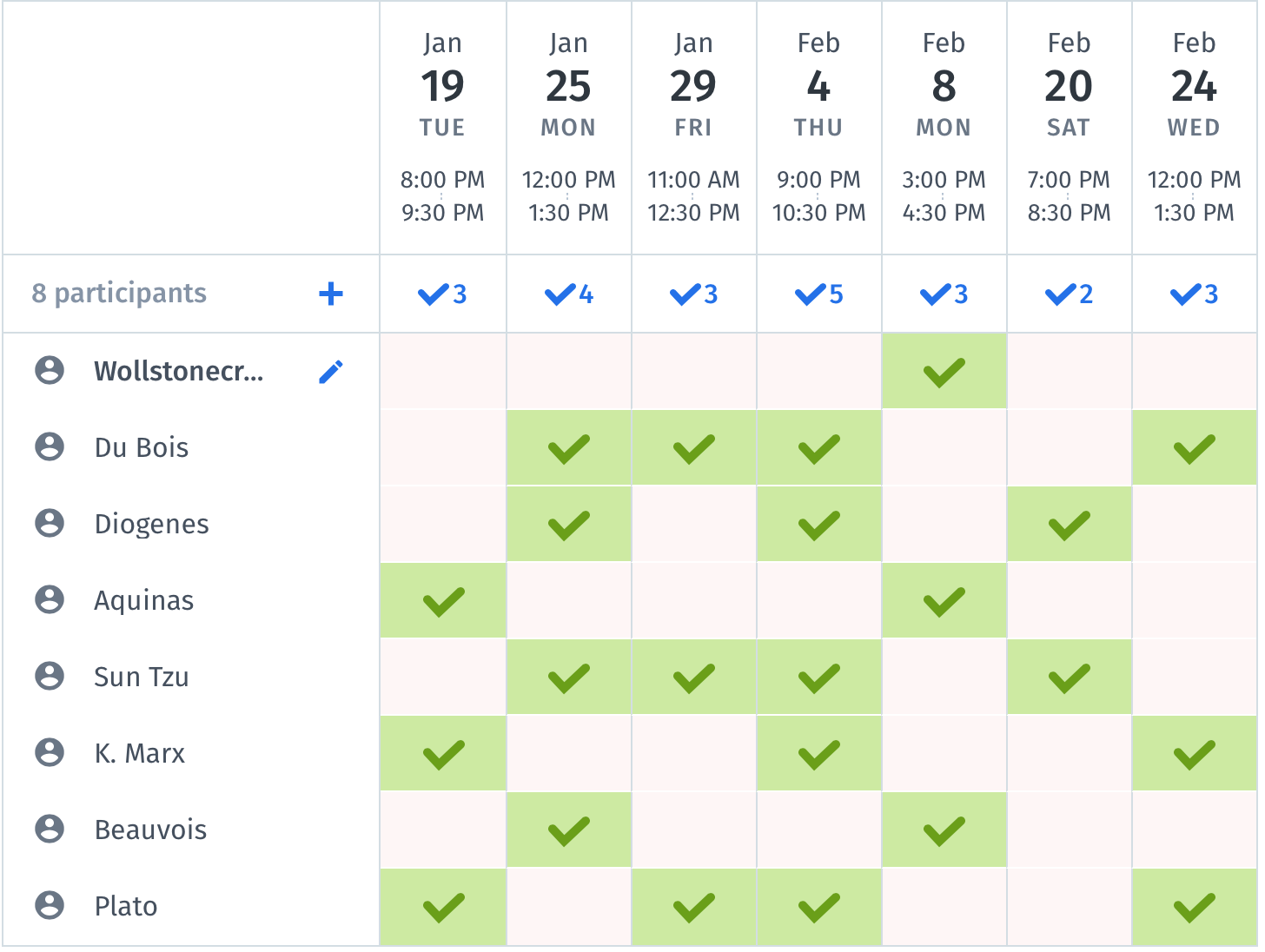A Guide for Organizing Online Philosophical Conversations (guest post)
When the pandemic pushed professional activities online, “we organized the ‘talks’ of conferences, but neglected the conversation,” writes Georgi Gardiner, assistant professor of philosophy at the University of Tennessee.
Professor Gardiner has facilitated a large number of Zoom events, including workshops, research circles, pedagogy blathers, and Zoom-based circus and work out groups. In the following guest post,* she explains how to use “availability-first scheduling” to organize small online group chats to help make up for how the pandemic has “eviscerated crucial features of normal-life social interaction.”
Availability-First Scheduling: Organizing Conversations Over Zoom
by Georgi Gardiner
This post explains how to efficiently facilitate small-group philosophy conversations online. The core idea is to find out when individuals are free, and arrange the groups based on availability. Do not start with the group members and try to find a time you are all available. Availability-first scheduling sidesteps the arduous scheduling rigmarole.
Early in the pandemic there was a flurry of organizing, as new Zoom-based presentation series sprung up. They provided valuable opportunities for learning about each other’s projects, sharing research, and—frankly—doing something. For many people, writing had ceased, and attending research talks was a welcome replacement.
As the pandemic wore on, needs shifted. People now yearn for conversation—free flowing, organic, informal, and fun. There are ample opportunities to experience the presentation parts of conferences, with attendant Q&As. But people miss causal chats whilst walking to the pub, meandering conversations over dinner, and the social intimacy of late night drinks at the bar, when the conversation has turned to anecdotes and vulnerabilities.
We organized the “talks” of conferences, but neglected the conversation. (A plea to conference organizers: Build in social time with groups of fewer than six people. Fifteen people in a Zoom room cannot chat.) Individuals can organize their own small group and one-to-one conversations, of course. But I propose a scale-up. In what follows I’ll explain how to facilitate many high-quality conversations with colleagues across philosophy. Firstly, I’ll say more about why.
The pandemic eviscerated crucial features of normal-life social interaction, such as:
- Getting to know new people, for example. Without in-person conferences, we are confined to contacting those we already know. This is particularly limiting for early career scholars.
- The congenial serendipity of ordinary social interaction—a little bit random, a little bit just right.
- A social calendar that extends for weeks or months into the future, offering conversations to look forward to on a normal social-life timescale.
- Social interactions that individuals didn’t need to organize themselves.
Colleagues have described how asking people to Zoom socially feels like asking them on a date. Shyness hinders, and people don’t initiate contact.
“I’m not shy”, I thought, “I can ask them out for you.”
Here is how: Email a lot of people at once. Between 12 and 40 works well. Select people you love chatting with, or people you’d like to know better. They need not all know each other; indeed it can be better if they don’t. Explain you want to organize an academic social for them. Offer invitees a range of 90-minute slots, spread out over the following two months. (The first date should not be within ten days of the initial email.) Ask them to fill in their availability for a social, and give them a deadline. Invitees can opt out by simply not filling in the poll. The poll will look like this:
You can offer to organize multiple socials for invitees: simply ask them how many they want. It is particularly helpful if some participants are flexible about how many they do, since this assists in arranging the groups.
After the deadline, download the availability data. Doodle is free and allows export into Excel. Match people into friendly groups of four. I love this part: Matchmaking for philosophy chat groups. Four seems just right for Zoom. With more than four it is difficult to enjoy free flowing conversation. If you plan to attend all the socials yourself, arrange groups of three. You are the fourth in every group.
Advice: Start with those participants with less availability, and work towards those with more scheduling flexibility. Once I have scheduled the person, I indicate this in the Excel sheet. In the image below, dark green is the scheduled time. And moving their entire row from centred text to left justified text signifies that the person has a time slot. In this example, I prioritised Wollstonecraft, because she was only available at one time, and Du Bois kindly volunteered to socialise twice, if needed.
Now simply tell attendees their time, group buddies, and Zoom location. If you won’t attend the social yourself, assign a ‘group leader’ to provide a Zoom link. You can email each group separately or send one large email to all invitees. The demands of etiquette depend on context. To be extremely time-efficient, you could simply send everyone the Excel table, with the extraneous columns deleted, so they can see their time slot and group members. I wouldn’t do this, it seems a tad brusque. You can also send reminder emails before the social.
Three practical considerations: The number of initial time slots you offer depends on how many people you invite, their level of availability, and whether the invite list spans time zones. You need sufficient time slots so that anyone who wants to participate can be slotted into a group. Suppose you invite 30 people and anticipate 15 will participate. That means you’ll arrange five socials. I recommend offering about 10 initial time slots. But that is just an estimate.
Secondly, you want a short timeframe between when people provide their availability information and when you tell them their chat time. Otherwise the availability data become outdated, as people schedule during times they said they were available. Thirdly, if the numbers don’t work out, or if people drop out, don’t worry about it: Facilitate a group of three or five. People won’t mind. You are organizing voluntary social events at a lonely time.
Whom to invite? Here are some ideas for invitee groups:
- People who research the same topic.
- Members of demographic groups, such as early career ethicists or Midwestern epistemologists.
- Existing groups, such as attendees of a recent conference or summer seminar, or members of a course, graduate program, or department.
This organizational approach can be applied to any group.
The events need not be purely social. Availability-first group creation can be used to establish groups with specific aims, such as peer-mentoring matrices, writing support groups, and discussion groups.
I suggested an upper limit of forty invitees. I doubt the system faces problems with higher numbers, but an organizer would only invite more people if they don’t plan to attend every session; otherwise they will have too many commitments. The system can facilitate a large peer-mentoring matrix, for example. Since the organizer doesn’t attend, multiple four-person groups can meet concurrently. And so one need not offer significantly more initial time slots.
A group can arrange to meet at the same time in a future week. The Excel sheet displays all the weekly times that all group members tend to be concurrently available, which is invaluable scheduling information. Or the original Doodle poll can ask for times that participants are free in a standard week, to facilitate recurring meetings.
The availability-first scheduling method matches participants according to availability. This is considerably smoother than determining the people first, and then trying to find a time they are all free.
Some further virtues: If you attend the events yourself, you thereby arrange a large part of your social calendar with minimal effort. With this system you can organize socials for depressed or frazzled friends, and build research communities. This is particularly helpful for early career academics and emerging research areas. Since you handpick the invitees, you spend time with people you love seeing at conferences, and you can easily introduce your friends to each other. It has felt like an easy way to facilitate socialising across career stages, which is commonplace at conferences but less common in Zoomland. The congenial contingency of the interactions can help spark new research or teaching ideas.
A variation: You can use this basic system to organize mentoring matrices or department socials with one senior member per group. To do this, start with times the professors can attend, then use the Doodle poll to offer those slots to grad students. Finally, add one professor or mentor to each group.
Another piece of pandemic social advice, if I may: When you contact a friend to initiate a one-on-one Zoom social, suggest meeting three times, spread out over the following three months. Arranging three chats over three months is not noticeably more difficult than arranging one chat. This is because you have already identified the weekly times you are both usually available. It pays dividends later: It’s nice to have something to look forward to and a sense of building something interpersonal.
When sending a large availability-first scheduling email, as outlined above, you might wonder whether you are inviting people to a social event or a professional one. Is this friendship, research, or academic service? My suggestion: Don’t worry about it. Just send the invitation. You don’t even need to explain the system. In lieu of an explanation, you can just link to this post. As I said, I’ll ask them out for you.





